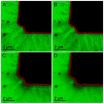(Press-News.org) OAK RIDGE, Tenn., Feb. 19, 2014 -- Using a new microscopy method, researchers at the Department of Energy's Oak Ridge National Laboratory can image and measure electrochemical processes in batteries in real time and at nanoscale resolution.
Scientists at ORNL used a miniature electrochemical liquid cell that is placed in a transmission electron microscope to study an enigmatic phenomenon in lithium-ion batteries called the solid electrolyte interphase, or SEI, as described in a study published in Chemical Communications.
The SEI is a nanometer-scale film that forms on a battery's negative electrode due to electrolyte decomposition. Scientists agree that the SEI's formation and stability play key roles in controlling battery functionality. But after three decades of research in the battery field, details of the SEI's dynamics, structure and chemistry during electrochemical cycling are still debated, stemming from inherent difficulties in studying battery electrode materials in their native liquid environment.
"We've used this novel in situ method to understand the dynamics of how this layer forms and evolves during battery operation," said Raymond Unocic, ORNL R&D staff scientist.
Battery researchers typically study the structure and chemistry of the SEI through "post-mortem" methods, in which a cycled battery is disassembled, dried and then analyzed through a number of characterization methods.
"This is problematic because of the air and moisture sensitivity of the SEI, and the ease by which environmental exposure can modify its structure and chemistry." Unocic said.
The ORNL researchers formed a miniature electrochemical cell by enclosing battery electrolyte between two silicon microchip devices that contain microfabricated electrodes and silicon nitride viewing membranes. The transparent "windows" seal the highly volatile battery electrolyte from the microscope's vacuum environment and allow the electron beam to pass through the liquid, which facilitates imaging of the electrochemical reaction products as they form.
To reproduce a battery charging cycle, the researchers applied a potential at the working electrode and monitored the resulting changes in current. The most striking result, said the researchers, was capturing an unprecedented view of SEI evolution during potential cycling. The technique is able to image the formation of tiny crystalline particles only one billionth of a meter in size.
"As we start to sweep the potential, we didn't initially observe anything," said lead author Robert Sacci, a postdoctoral research fellow with ORNL's FIRST Energy Frontier Research Center. "Then we started seeing shadows -- presumably polymeric SEI -- forming into a dendritic pattern. It looks like a snowflake forming from the electrode." Watch a video of the process at http://www.youtube.com/watch?v=OHrlFNB-Q9Y.
The researchers plan to build on this initial proof-of-principle study to better understand the factors behind the SEI's formation, which could ultimately help improve battery performance, capacity, and safety at the device level.
"Tailoring the SEI's structure and chemistry to maximize battery capabilities appears to be a delicate balancing act," Unocic said. "When you cycle a real battery, the interphase structure can form, break, and reform again, depending on how thick the layer grows, so we need to look at improving its structural stability. But at the same time, we have to think about making the interphase more efficient for lithium ion transport. This study brings us one step closer to understanding SEI formation and growth."
Next steps for the researchers include applying their technique to study different types of battery electrodes and electrolytes and other energy storage systems including fuel cells and supercapacitors.
INFORMATION:
Coauthors are ORNL's Raymond Unocic, Robert Sacci, Nancy Dudney and Karren More; and Pacific Northwest National Laboratory's Lucas Parent, Ilke Arslan, Nigel Browning. The study is published as "Direct Visualization of Initial SEI Morphology and Growth Kinetics During Lithium Deposition by in situ Electrochemical Transmission Electron Microscopy."
The research was supported by the DOE's Office of Energy Efficiency and Renewable Energy, Vehicle Technologies Program, by the Fluid Interface Reactions Structures and Transport (FIRST) Center, an Energy Frontier Research Center funded by the Office of Basic Energy Sciences, and as part of a user proposal at ORNL's Center for Nanophase Materials Sciences. Parts of the work were supported by the laboratory directed research and development program at Pacific Northwest National Laboratory and the Joint Center for Energy Storage Research, an Energy Innovation Hub funded by BES-DOE.
Part of this research was conducted at the Center for Nanophase Materials Sciences, which is sponsored at ORNL by the Scientific User Facilities Division in DOE's Office of Basic Energy Sciences. CNMS is one of the five DOE Nanoscale Science Research Centers supported by the DOE Office of Science, premier national user facilities for interdisciplinary research at the nanoscale. Together the NSRCs comprise a suite of complementary facilities that provide researchers with state-of-the-art capabilities to fabricate, process, characterize and model nanoscale materials, and constitute the largest infrastructure investment of the National Nanotechnology Initiative. The NSRCs are located at DOE's Argonne, Brookhaven, Lawrence Berkeley, Oak Ridge and Sandia and Los Alamos national laboratories. For more information about the DOE NSRCs, please visit http://science.energy.gov/bes/suf/user-facilities/nanoscale-science-research-centers/.
UT-Battelle manages ORNL for the Department of Energy's Office of Science. DOE's Office of Science is the single largest supporter of basic research in the physical sciences in the United States, and is working to address some of the most pressing challenges of the time. For more information, please visit science.energy.gov.
Image: http://www.ornl.gov/Image%20Library/Main%20Nav/ORNL/News/News%20Releases/2014/Unocic_highres.jpg?code=2c013fd7-44e3-49d8-9c49-179df9f96964
Caption: A new in situ transmission electron microscopy technique enabled ORNL researchers to image the snowflake-like growth of the solid electrolyte interphase from a working battery electrode.
NOTE TO EDITORS: You may read other press releases from Oak Ridge National Laboratory or learn more about the lab at http://www.ornl.gov/news. Additional information about ORNL is available at the sites below:
Twitter - http://twitter.com/oakridgelabnews
RSS Feeds - http://www.ornl.gov/ornlhome/rss_feeds.shtml
Flickr - http://www.flickr.com/photos/oakridgelab
YouTube - http://www.youtube.com/user/OakRidgeNationalLab
LinkedIn - http://www.linkedin.com/companies/oak-ridge-national-laboratory
Facebook - http://www.facebook.com/Oak.Ridge.National.Laboratory
ORNL microscopy system delivers real-time view of battery electrochemistry
2014-02-19
ELSE PRESS RELEASES FROM THIS DATE:
Many Texans struggling to pay for health service as Affordable Care Act is about to launch
2014-02-19
HOUSTON – (Feb. 19, 2014) – Many Texans were struggling to pay for basic health services on the eve of the launch of the Affordable Care Act's Health Insurance Marketplace, according to a report released today by Rice University's Baker Institute for Public Policy and the Episcopal Health Foundation. The report also found that even those with health insurance reported dissatisfaction with the cost and availability of services. Most Texans expect more of the same in 2014.
The Health Reform Monitoring Survey (HRMS)-Texas report is based on the HRMS, a national project that ...
Molecular aberration signals cancer
2014-02-19
Several scientists, including one at Simon Fraser University, have made a discovery that strongly links a little understood molecule, which is similar to DNA, to cancer and cancer survival.
EMBO Reports, a life sciences journal published by the European Molecular Biology Organization, has just published online the scientists' findings about small non-coding RNAs.
While RNA is known to be key to our cells' successful creation of proteins, the role of small non-coding RNAs, a newly discovered cousin of the former, has eluded scientific understanding for the most part. ...
Cell therapy shows remarkable ability to eradicate cancer in clinical study
2014-02-19
NEW YORK, February 19, 2014 — Investigators from Memorial Sloan Kettering Cancer Center have reported more encouraging news about one of the most exciting methods of cancer treatment today. The largest clinical study ever conducted to date of patients with advanced leukemia found that 88 percent achieved complete remissions after being treated with genetically modified versions of their own immune cells. The results were published today in Science Translational Medicine.
"These extraordinary results demonstrate that cell therapy is a powerful treatment for patients who ...
LGBT youth face greater cancer risks, CCNY-led study
2014-02-19
A new study led by City College of New York psychologist Margaret Rosario found that youths of same-sex orientation are more likely to engage in behaviors associated with cancer risk than heterosexuals. The peer-reviewed findings appear in the February 2014 issue of the American Journal of Public Health.
Titled "Sexual Orientation Disparities in Cancer-Related Risk Behaviors of Tobacco, Alcohol, Sexual Behaviors, and Diet and Physical Activity: Pooled Youth Risk Behavior Surveys," the study pooled YRBS (Youth Risk Behavior Survey) data from 2005 and 2007. The YRBS is ...
Using holograms to improve electronic devices
2014-02-19
RIVERSIDE, Calif. (http://www.ucr.edu) — A team of researchers from the University of California, Riverside Bourns College of Engineering and Russian Academy of Science have demonstrated a new type of holographic memory device that could provide unprecedented data storage capacity and data processing capabilities in electronic devices.
The new type of memory device uses spin waves – a collective oscillation of spins in magnetic materials – instead of the optical beams. Spin waves are advantageous because spin wave devices are compatible with the conventional electronic ...
Statistics research could build consensus around climate predictions
2014-02-19
Philadelphia, PA—Vast amounts of data related to climate change are being compiled by research groups all over the world. Data from these many and various sources results in different climate projections; hence, the need arises to combine information across data sets to arrive at a consensus regarding future climate estimates.
In a paper published last December in the SIAM Journal on Uncertainty Quantification, authors Matthew Heaton, Tamara Greasby, and Stephan Sain propose a statistical hierarchical Bayesian model that consolidates climate change information ...
Smellizing -- imagining a product's smell -- increases consumer desire, study finds
2014-02-19
Seeing is believing, but smellizing – a new term for prompting consumers to imagine the smell of a product – could be the next step toward more effective advertising.
Researchers came to this conclusion through four studies of products most of us would like to smellize: cookies and cake.
Professor of Marketing Maureen Morrin of Temple University's Fox School of Business co-authored Smellizing Cookies and Salivating: A Focus on Olfactory Imagery to examine the impact imagining what a food smells like would have on consumer behavior.
"Before we started this project, ...
Discovery by Baylor University researchers sheds new light on the habitat of early apes
2014-02-19
WACO, Texas (Feb. 18, 2014)-- Baylor University researchers, in collaboration with an international team of scientists, have discovered definitive evidence of the environment inhabited by the early ape Proconsul on Rusinga Island, Kenya. The groundbreaking discovery provides additional information that will help scientists understand and interpret the connection between habitat preferences and the early diversification of the ape-human lineage.
Their research findings--published this month in Nature Communications--demonstrate that Proconsul and its primate relative Dendropithecus ...
Graduate student makes major discovery about seal evolution
2014-02-19
Ottawa, February, 19, 2014—In the world of science, one of the most exciting things a researcher can do is pin down an answer to a widely asked question. This experience came early for Carleton University graduate Thomas Cullen, who made a discovery about pinnipeds—the suborder that makes up seals, sea lions and walruses—while doing research for his Master's degree under the supervision of Canadian Museum of Nature palaeontologist Dr. Natalia Rybczynski.
His discovery, published the journal Evolution, relates to sexual dimorphism (a large variance in size between males ...
Huntington's disease: Hot on the trail of misfolded proteins' toxic modus operandi
2014-02-19
WASHINGTON D.C. Feb. 19, 2014 -- Proteins are the workhorses of the cell, and their correctly folded three-dimensional structures are critical to cellular functions. Misfolded structures often fail to properly perform these vital jobs, leading to cellular stress and devastating neurodegenerative disorders such as Alzheimer's, Parkinson's and Huntington's disease.
In comparison with the mysteries of Alzheimer's or Parkinson's disease, Huntington's disease has a seemingly simple culprit: an expansion in the polyglutamine (polyQ) tract of a protein called "Huntingtin" (Htt). ...






